Gotoku: Trivet in Tea and Beyond
In Chanoyu, the kama, 釜, kettle, is supported in the sunken ro, 炉, hearth, on a trivet-like iron go-toku, 五德, five-virtues. The gotoku is a wa, 輪, ring, with three ashi, 足, legs, ending in triangular tsume, 爪, talons. The ring is buried in the ash bed, so that only the legs and the talons are visible.
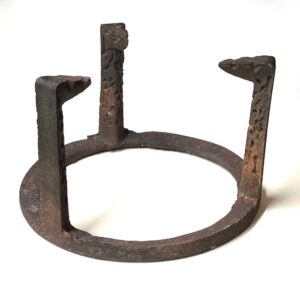
There are essentially two positions for the gotoku. The most formal arrangement has a tsume pointed toward the host, tei-shu, 亭主, house-master, with two tsume at the front. The other more common placement has the tsume on the right side pointing directly left, toward the place where a lamp, tan-kei, 短檠, short-frame, can be displayed. This tsume is called the kei-zume, 檠爪, rack-talon.
Chanoyu adheres to Rikyū’s concept of Cha Zen Ichi Mi, 茶禅一味, Tea Zen One Taste. Rikyū’s belief in Zen was not the only aspect of Buddhism, and like many Japanese people, he had wider beliefs that included the teachings from Taoism, Shintō, and others. He was a lay priest that afforded him the title of Ko-ji, 居士, Resident-scholar, Sanskrit, Grihapati, Buddhist householder. Rikyū was known throughout most of his life as Sō-eki, 宗易, Sect-change. The word adopted from the I Ching, Jpn. Eki-kyō, 易経, Change-sutra. Rikyū’s memorial temple is Jukōin, 聚光院, Gather-light-sub temple, of in Daitokuji, 大徳寺, Great-virtue-temple. The Juichimen Kannon is among the Buddhist deities revered in Buddhism.
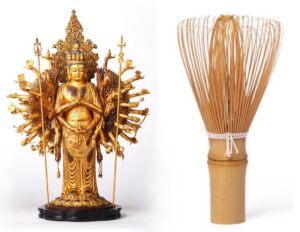
Sen-ju Kan-non Bo-satsu, 千手観音菩薩, Thousand-hand See-sound Grass-buddha, also known as Jū-ichi-men Kan-non, 十一面觀音, Ten-one-face See-sound, gilt wood figure. Cha-sen, 茶筅, tea-whisk, take, 竹, bamboo, with white thread braid that separates the outer from the inner tines; for use in very formal and offering Tea presentations. A chasen may have 80 to 120 tines, and is essential in creating and serving ma-tcha, 抹茶, powdered-tea, as koi-cha, 濃茶, thick-tea, and usu-cha, 薄茶, thin-tea.
According to Asian philosophy, enlightenment can be symbolized by a thousand-petaled lotus. It is also known as the Sahasrara padma or Crown chakra located just above the head, and is a symbol of spiritual enlightenment and supreme consciousness. The lotus is closely associated with Buddhism, and is closely associated with the Thousand-hand Kannon, who also has one thousand eyes.
Kannon has 33 different manifestations. Kannon holds the primary hands together and thanks, and the secondary hands supports a lotus flower as a seat for an enlightened soul, which may be likened to a cha-wan, 茶碗, tea-bowl. Among the many hands, Kannon holds a san-sa-soku, 三叉槍, three-fork-lance, in one of the left hands, and the shaku-jō, 錫杖, tin-staff, in one of the right hands. In Chanoyu, the three prongs of the Buddhist trident may evoke the trivet go-toku, 五徳, five-virtues, used to support the kama, 釜, kettle. The metal rings of the shakujō may evoke the kan, 鐶, metal rings, used to move the kama.
According to multiples theories stemming from Southeast Asia and China, the five fingers of the human hand are identified with the five physical element. In Japanese, the elements are called the Go-gyō, 五行, Five-transitions, physical elements. The fingers may be identified with the five participants in a Tea gathering:
Thumb is identified with: Ka, 火, Fire. Tei-shu, 亭主, House-master.
First finger is identified with: Gon, 金, Gold/Metal. Shō-kyaku, 正客, True-guest.
Second finger is identified with: Moku, 木, Wood. Ji-kyaku, 次客, next-guest.
Third finger is identified with: Do, 土, Earth. San-kyaku, 三客, third-guest.
Fourth finger is identified with: Sui, 水, Water. Ma-kkyaku, 末客, end-guest, also called tsume, 詰め, close(er). The tsume may assist the teishu, as well as enter the preparation room, mizu-ya, 水屋, water-room.
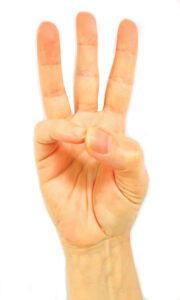
The Varuna Mudra. This mudra focuses on the transition and disposition of water and other fluids. The thumb (fire) and little finger (water) are joined together in this mudra. The teishu and the tsume are, in a way, joined to create an ideal tea presentation. The thumb and little finger make a ring, and the three remaining fingers may evoke the ring and legs of the gotoku.
In Chanoyu, the change from using the fu-ro, 風炉, wind-hearth, to using the ro, 炉, (sunken) hearth occurs during the change from the Asian zodiac sign of the Boar, I, 亥, to the sign of the Rat, Ne, 子, in accord with the lunar 10th month. The sign of the Boar is associated with A-mi-da Nyo-rai, 阿弥陀如来, Praise-increase-steep Like-become, and the sign of the Rat is associated with Jū-ichi-men Kan-non, 十一面觀音, Ten-one-face See-sound. Kannon is the Water aspect of Amida, and wears an image of Amida on her crown. Amida is a savior to all, and illuminates the world. The Fire aspect of Amida is Sei-shi Bo-satsu, 勢至菩薩, Strength-attain Grass-buddha.
Kannon with her/his thousand hands and eleven heads can help humans achieve anything in their pursuits. Kannon is caring, and wishes to save humans and all living things through actions. Kannon carries a lotus flower to transport a soul to the western paradise Goku-raku Jō-do, 極楽浄土, Extreme-pleasure Pure-land, of Amida. Note the moustache, which indicates that Kannon is a male deity in female form.
Of the eleven faces on Kannon’s crown, a small figure of Amida is at the front. Three heads are benevolent and calm like Bosatsu, three have wrathful expressions, and three are grinning with fangs protruding upward. On the top is the head of the Buddha. On the back of the Kannon’s head is a violently laughing head called Bō-aku Tai-shō-men, 暴悪大笑面, Outburst-evil Great-laugh-face; it is believed that anger at the stupid actions of humans, culminates in Buddhist laughter.
Were there a connection between the eleven faces of Kannon and the features of the ro, nine of the faces may relate to the nine surfaces of the three triangular legs of the gotoku. The front facing figure of Amida could be identified with the kama, the Amida-dō gama, in particular. What of the laughing head of the eleven heads? Perhaps the fire? Or, perhaps because the violently laughing head is at the back of Kannon’s head, and is unseen from the front, this face could be the ring, rin, 鐶, of the gotoku that holds the three legs together. Unseen in the ash bed, the ring could be identified with the open mouth laughing head. The laughing head wears a crown that has a triangular image of Amida.
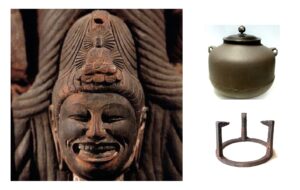
Sculptural head of Bō-aku Dai-shō-men, 暴悪大笑面, Outburst-evil Great-laugh-face, on the back of the head of the figure of Jū-ichi-men Kan-non, 十一面觀音, Ten-one-head See-sound. National treasure at Shi-un-zan Kō-gen-ji, 紫雲山向源寺, Purple-cloud-mountain Opposite-origin-temple, Taka-tsuki-chō, 高月町, High-moon-town, Shi-ga-ken, 滋賀県, Nourish-joy-prefecture. Note the laughing head’s earlobes elongated by heavy earrings that may be likened to the lug holes of the kama’s kan-tsuki, 鐶付, metal ring-attach.
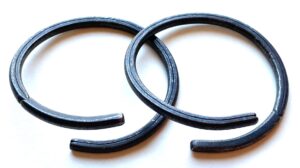
The three-sided image of the laughing head on Amida on Kannon’s head may evoke the three tsume of the gotoku. The iron gotoku ring could be likened to the rin, 輪, ring, of Kannon’s Nyo-i-rin Hō-ju, 如意輪観音, Like-mind-ring See-sound, the wish-granting jewel. The image of Amida and the laughing head are on opposing sides of Kannon’s head, just as the Amidadō gama is opposite the hidden ring of the gotoku. The charcoal fire in the hearth is within the ring of the gotoku.
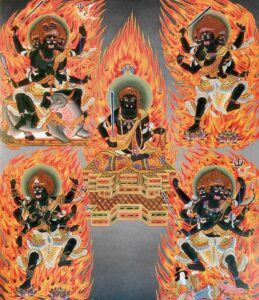
In Buddhism, anger is identified with fire, which is depicted in images of Fudō Myō-ō, 不動明王, No-move Bright-king, one of the Go-dai-myō-ō, 五大明王, Five-great Bright-kings, who controls the fires of anger. The Go-dai-myō-ō are present during the offerings of Buddhist ritual fires, go-ma, 護摩, protect-polish. Perhaps when the teishu builds the charcoal fire in the ro, and the four guests gather around the hearth, they represent the Five Myō-ō at a goma, with the teishu representing Fudō Myō-ō.
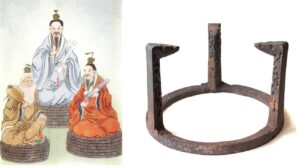
In ancient Taoism, the three most highly esteemed gods are called, in Japanese, the San-sei, 三清, Three-pures. They are individual classified as a hashira, chō, 柱, post, counter for a deity. The Kanji 柱 is composed of ki, moku, 木, tree, and shu, nushi, 主, master (of fire). The deities are energy forces of the universe anthropomorphized into human beings depicted as aged emperor sages, one with white hair and a beard. They are (also in Japanese): Yuan-shi Tian-zun, (Gen-shi Ten-son), 元始天尊, Origin-begin Heaven-lord; Ling-bao Tian-zun (Rei-hō Ten-son), 靈寶天尊, Spirit-treasure Heaven-lord; Dao-de Tian-zun, (Dō-toku Ten-son), 道德天尊, Way-virtue Heaven-lord.
Genshi Tenson is depicted wearing a light blue robe, and often holds a hō-ju, 宝珠, treasure-jewel. It is important to remember that the kō-gō, 香合, incense-gather, is a representation of the hōju. In the above image of the three deities, the Genshi Tenson holds the Nyo-i, 如意, Like-desire, in Chinese, ruyi lingzhi mushroom, scepter of immortality. Rei-hō Ten-son on the right holds a scroll of wisdom, Dō-toku Ten-son on the left holds a Buddhist uchiwa, 団扇, round-fan, with ho-ssu, 払子, banish-of, horse tail fly whisk, these three long narrow objects could be identified with the three ashi legs of the gotoku.
Robes are the primary basic colors of red, blue, and yellow, and sometimes green. According to a general search, ‘fire can appear in many colors, including red, orange, yellow, white, and blue’. In Asia, the colors blue and green are often identified as the other.
Genshi Tenson in the center sits on seven stacked cushions. The same might be found in the bent ornaments on the three headgear, which mimic the bent tsume of the gotoku. Rei-hō Ten-son in orange sits on six cushions. Dō-toku Ten-son in tan sits on five cushions. The round cushions illustrated are likely made of straw, sedge, grass, etc.
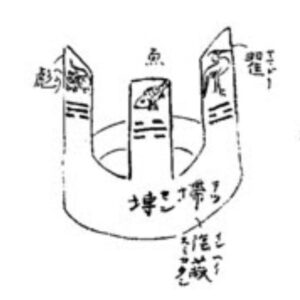
Ring trivet of a Chinese ‘cauldron’,ding 鼎 ‘tripod, identified in Japanese as a go-toku, 五徳, to support a kama, 釜, kettle, in a fu-ro, 風炉, wind-hearth. The ashi/legs in the picture of the gotoku are identified from the left: ashi marked with the trigram, ☴, Son, Tatsu-Mi, 巽, Dragon-Snake. Son is identified with Wind and the direction of the Southeast. The middle ashi is marked with the trigram, ☵, Kan, 坎, Hole, which is identified with, Ne, 子, Rat, and is identified with Water and the direction of the North, and has a design of a fish; the ashi on the right is the trigram, ☲, Ri, 離, Detach, which is identified with Uma, 午, Horse, and is identified with Fire, and the direction of the South, and has a design of a bird (crane?).
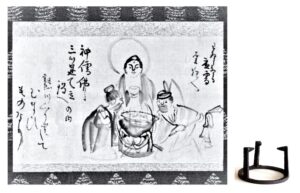
Kake-jiku, 掛軸, hang-scroll, with an ink drawing of three figures and text: San-sei Kyū-san’, 三聖吸酸, Three-saints sip vinegar, by Sen-gai Gi-bon, 仙厓義梵, Hermit-cliff Righteous-buddha; Ide-mitsu Bi-jutsu-kan, 出光美術館, Out-light Beauty-art-hall.
Depicted in the kakejiku are Buddha, Kō-shi, 孔子, Great-child, in the center who is also known as Confucius is pictured on the right, and Sen Ri-kyū, 千利休, Thousand Rich-quit, on the left. Note the gotoku ashi at the back is the same as the elevated location of the Buddha in the drawing.
Text left of the three figures:
‘Shin Ju Butsu mitsu ashi de tate-nabe he no nai jukkuri toshite mu-mai mono nari.’
神儒仏三つ足で立鍋への内 塾っくりとしてむまい(無味?)ものなり
Shintō Confucianism Buddhism three legs of tall-pot of ’s in schooling then (no-taste) thing becomes.
Kanji for consideration:
Shin-Ju-Butsu, 神儒仏: Kami, 神, (Shintō) god, Ju, 儒, Confucian, Butsu, 佛, Buddha.
San-mai-, 三昧, three-darks, samadhi, state of intense concentration achieved through meditation.
See also the Sengai kakejiku in the addendum below.
The scene on the hanging scroll is a variation of San-sei Kyū-san, 三聖吸酸, Three-saints sip vinegar. Other San-sei groups are Buddha, Confucius and Christ, another example is Buddha, Confucius, and Lao-tzu; etc. Taishang Laojun, Tai-jō Rō-kun, 太上老君, Grand-upper Old-ruler, is also called Lao-tzu, the supreme divinity of Taoism, and as Dō-toku Ten-son, 道德天尊, Way-virtue Heaven-lord.
A prominent feature in the picture of the three vinegar tasters is the go-toku, 五徳, five-virtues, trivet. The ring, uniting the three ashi and tsume is shown, and not buried in an ash bed as it would be in the ro. The jiku has a light area in the gotoku that appears to depict fire. In both the above jiku and in Chanoyu, the charcoal fire in the hearth is within the ring of the gotoku. This fire is propagated by the lighting of the three pieces of burning charcoal, shita-bi, 下火, down-fire. The shitabi may also evoke the three mallet heads used to support the New Year’s fire. The mallet heads are called gi-tchō, 毬打, ball-hit, which is the name of the most common pieces of charcoal of the hearth fire.
Fire is a central metaphor of Buddhism, typically as a negative quality of mind or consciousness. Putting out these fires is the goal of Buddhist practice. The word nirvana is derived from the extinguishing of fire. Shariputra, one of the Buddha’s chief disciples, was once asked, “What is nirvana?” He answered, “The destruction of greed, the destruction of anger, the destruction of delusion—this is nirvana.
Though commonly referred to as poisons, the Buddha first introduced these mental attitudes as fires in the Fire Sermon, Adittapariyaya Sutta, Hi no Se-ppō, 火の説法, Fire’s Explain-law, “Monks, all is burning . . . Burning with what? Burning with the fire of lust, with the fire of hate, with the fire of delusion.”
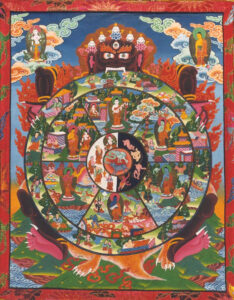
The ‘three poisons’ are depicted at the center of the Wheel of Life (bhavachakra), a visual representation of the sorrows of samsara. Greed is depicted as a rooster, hatred as a snake, and delusion as a pig. Importantly, they actually feed off one another; each animal consuming the tail end of the other in a vicious cycle of delusion. The centrality of the three poisons demonstrates their role in powering the cycle of birth, death, and rebirth, the escape from which is Nirvana, (Jpn. Ne-han, 涅槃, Soil-tub).
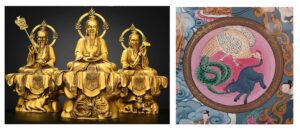
There is an ancient Chinese – Japanese expression of Ryū-sui Kaku-go, 龍吹鶴語, Dragon-blowing crane language: the dragon’s snort and the crane’s cry. The phrase envisions a scene of wild animals roaring and the crane’s cries ringing out as an allegory for the world where diverse values exist. Perhaps the kama of Chanoyu, with its sound of simmering water, can be likened to the dragon and the crane, which are often linked. The lugs often resemble dragon heads.
When water in the kama begins to make sounds likened to, matsu-kaze, 松風, pine-wind, and begins to emit steam, it could be seen as dragon’s breath, and dragons create clouds, and bring rain. According to Asian astrology, among the Shi-shin, 四神, Four-gods, is the Sei–ryū, 青龍, Azure-dragon, that rules over the eastern quadrant of the heavens. The Dragon in the east, identified with the Chanoyu kama, establishes the location of the teishu in the west. According to the I Ching/Ekikyō, the sign of the Dragon, Tatsu, 辰, is located in the east/southeast, which is source of the ‘good wind’, and in the Tearoom is close to the small nijiri–guchi, 躙口, crawl in-opening, where the host and guests enter and exit the Tearoom.
Dragon breath creates clouds, kumo; together called un-ryū, 雲龍, cloud-dragon. An important kama in Chanoyu is Rikyū’s un-ryū gama, 雲龍釜, cloud-dragon kettle, which has an image of a dragon among clouds. Incense in the hearth creates fragrant smoke that can be seen as clouds, kumo, 雲. The cry of the crane, tsuru, 鶴, is a vocal utterance that is musical to the Asian sense of hearing. The word ‘tsuru’ can be written with the Kanji, 釣, suspend, angle, hang, etc, and 弦, bowstring, 蔓, vine, tendril, etc.
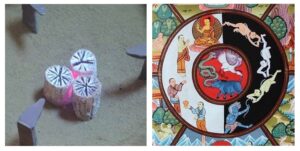
There are many variations of the three animals with the pig usually at the bottom, and they may be headed in either direction. It is curious to note that the ro/hearth is opened on an I-no-hi, 亥の日, Wild-boar/pig, day, in the month of the boar/pig. Also, the pig/boar, pigeon/chicken, and snake are associated with Buddhist guardian deities, and yet represent the Three Poisons of Buddhism. When building the charcoal fire in the hearth, the front piece of burning charcoal shita-bi, 下火, down-fire, is moved to the back of the other two pieces of burning charcoal. This changes the direction of the circle.
The central element of the San doku is surrounded by a half black and half white ring that has eight figures that illustrate the potential evolution that results from the three poisons. The four figures in the black zone are descending into violence, symbolized by the rope held by a demon that binds them together. While the four figures in the white zone are in the act of offering, and ascending to Buddhahood. The three poisons can evoke negative and positive responses. Fire can destroy or cook food. This ring is surrounded by the Roku–dō, 六道, Six-ways. The six realms are the Deva, Asura, Human, Animal, Hungry Ghost, and Hell realms.
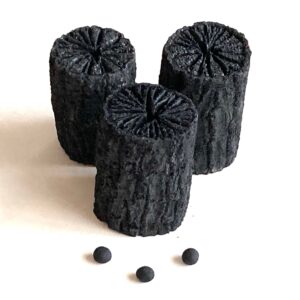
The shitabi charcoal is made of a kind of oak called kunugi, 椚. After the wood is fired its physical structure forms radiating fissures that resemble the petals of the chrysanthemum which gives its familiar name of kiku-zumi, 菊炭, chrysanthemum charcoal. Preferred Charcoal for Tea is Ike-da zumi, 池田炭, Pond-field charcoal, Nose, Ōsaka.
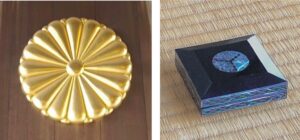
In Japanese traditional design, the kiku has special significance and symbolism, and is the imperial crest of the emperor. It is depicted in different forms, especially with 16 or 32 petals. A familiar family crest is the mitsu-wari-giku, 三つ割り菊, three-divide-chrysanthemum.
The three pieces of incense are placed in the ro before the ignited gitchō, which, when burning, are called shita-bi, 下火, down-fire. This burning of incense may be, metaphorically, regarded as medicine to transmute the three ‘poisons’. The shitabi are placed with one piece in front of two pieces. When first building the charcoal fire, the front burning piece of charcoal is moved to be behind the two pieces of burning charcoal. This transfer changes the shō-men, 正面, true-face, of the fire. The fire causes the charcoal and the incense to be useful, and causes action in the Tearoom.
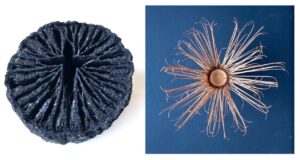
The natural pattern of flower-like radiating wood grain lines gives this kind of charcoal the name of kiku-zumi, 菊炭, chrysanthemum-charcoal. Note the Kanji for kiku includes the Kanji for kome, 米, rice, with its radiating lines. The two essential Chanoyu utensils show the positive and negative, In Yō, 陰陽, Yin Yang aspects of objects. Wood and bamboo are both plants. Wood is transformed by fire into charcoal, which is burned to heat water. Charcoal is also made out of bamboo. The bamboo is softened in boiling water to help bend the tines of the chasen, which whisks hot water with tea. Charcoal and the bamboo whisk are connected to fire and water, and manifest both In and Yō.
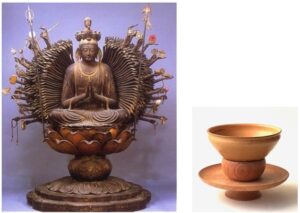
The Thousand-hand Kannon holds many objects within her control. Objects include, the sun and the moon, trident, spear, treasure jewel, bow and arrow, mirror, Vajra, tiny buddhas, begging bowl, pagoda, conch shell, water pitcher, bell, treasure chest, pilgrim staff, lotus flower seat, etc. Among the objects are utensils that have their counterparts in Chanoyu and presentation Tea.
‘Ten-moku’ cha-wan, 天目茶碗, Heaven-eye tea-bowl, Kikkō yaki, 吉向焼, Good luck-beyond-fired; diam. 4.4 x 2.3 sun kane-jaku. Made in 1963 for the 700th anniversary of the Shin-ran, 親鸞, Parent-mythic bird, [1173-1263] founder of the Jō-do Shin-shū, 浄土真宗, Pure-land New-sect, given at Higashi-Hon-gan-ji, 東本願寺, East-True-vow-temple, Kyōto. Such bowls and stands are used to serve the nobility and in offerings of Tea to deities like Kannon.
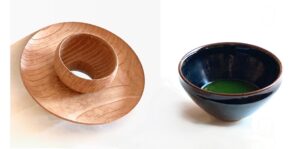
The dai and chawan represent the Go-rin, 五輪, Five-rings, five principles: from the bottom; dai = do-i, 土居, earth-is, Chi, 地, Earth; hane, 羽, wing (circle), Mizu, 水, Water; hōzuki, 鬼灯, demon lamp (flaming hō-ju, 宝珠, treasure-jewel), Hi, 火, Fire. The cha-wan, 茶碗, tea-bowl, full or empty, Fū, 風, Wind; tea is the Kū, 空, Void, water and tea – undifferentiated In and Yō, 陰陽, Yin Yang.
In Pali literature, four of the five elements are known as the maha-bhuta, great-elements, or catu-dhatu, four elements, which are Earth, Water, Fire, and Air/Wind. To complete the five elements, the dai is made of wood (identified as Wind), and the stand is hollow and identified as the Void.
The four elements identified in literature and some examples of their presence are:
Earth: the solidity of the body, the ground, and water
Water: blood, urine, sweat, tears, and water
Fire: temperature, the ability to digest, and eat
Air/Wind: the body’s breath, wind, and movement
Metaphorically, the dai is a kind of gotoku. The trivet legs may be identified with the three life-supporting elements of earth, water, and fire. The ring of the gotoku is like the opening through the dai, which could be identified with both wind and the void.
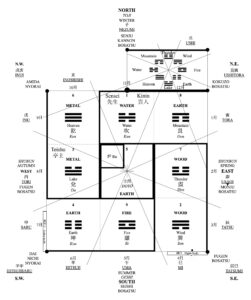
Diagram of an idealized yo-jō-han cha-shitsu, 四畳半, four-mat-half tea-room, showing the locations of the eight Buddhist guardian deities. Sen-ju Kan-non Bo-satsu, 千手観音菩薩, Thousand-hand See-sound Grass-buddha, is located in the middle of the north direction including half of the tokonoma, and may be identified with the toko-bashira, 床柱, floor-post. The location of a teacher, sen-sei, 先生, before-life, is directly in front of the ro, so as to assume the active nature of Kannon.
The location of a ki-nin, 貴人, noble-person, at a Tea presentation, is located so as to have access to the area next to the ro, and acts as the passive recipient nature of Kannon. There are occasions when the kinin would sit in the tokonoma. The shōkyaku acts on behalf of the kinin, whether present or not. When a kinin is not present, The shōkyaku becomes a kind of kinin, and prior to sitting, the shōkyaku turns her or his back to the tokonoma, taking on the ‘mantle’ of the kinin. To show this connection, the shōkyaku places the folding sen-su, 扇子, fan-of, on the floor near the feet, with the pivot toward the tokonoma, and/or in the direction opposite the other guests.
For further study, see also: Ro and Hai: Hearth and Ash and Ro: The Sunken Hearth Collection
Addendum to above kakejiku of San-sei Kyū-san’, 三聖吸酸, Three-saints sip vinegar, by Sen-gai Gi-bon, 仙厓義梵:
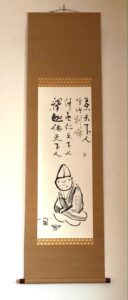
Kake-mono, 掛物, hang-thing, Rikyū no e, 利休の絵, Rikyū’s picture. With calligraphy from the left:
釈迦仏天下人
Sha-ka Butsu ten-ka-jin,
Explain-‘ka’ Buddha heaven-down-person
[Shaka or Sakya is Buddha’s family name].
仲尼仁天下人
Chū-ji Jin ten-ka-jin,
Relation-nun Benevolence heaven-down-person
[Chūji, in Chinese, Kongzi is Confucius’ family name].
唯比利休
tada-hi Ri-kyū
only-same Rikyū
the same is for
茶天下人
Tea ten-ka-jin
Tea heaven-down-person.
by Sen-gai Gi-bon, 仙厓義梵, Hermit-precipice Righteous-Sanskrit. [1750-1837]. L. 5.5 shaku kane-jaku. Print.

